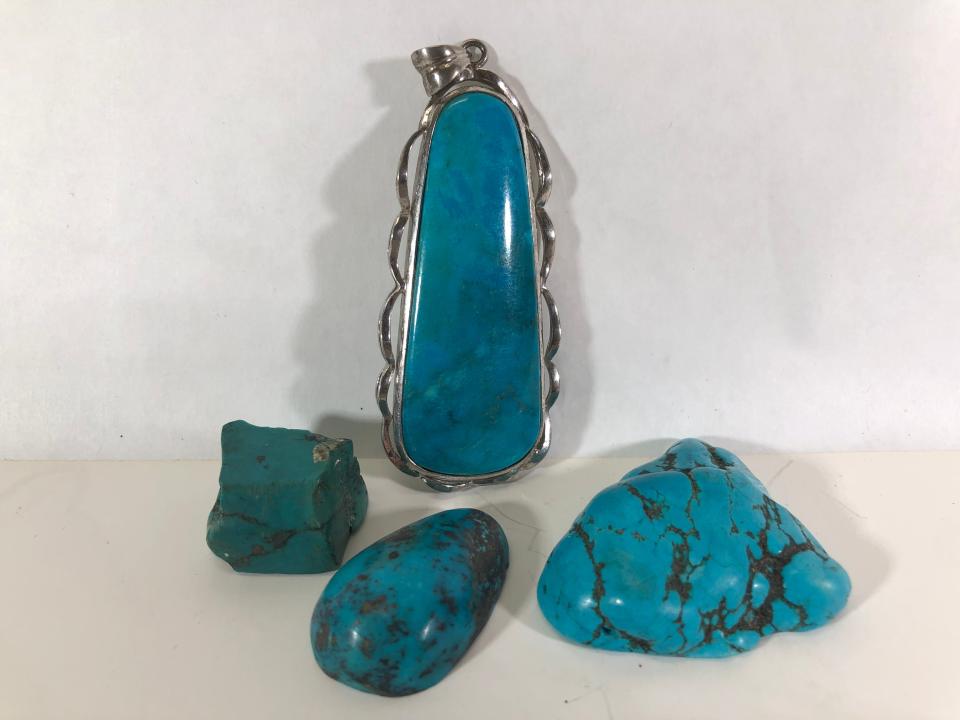Antiques: Turquoise is a stone for the ages
In galleries like ours, nothing turns heads like vintage jewelry. All kinds attract attention, but pieces with a Southwest or Native American theme tend to draw the biggest crowds. And if there's a signature element to jewelry like that, it's the presence of turquoise.
From the earliest days, turquoise was mined throughout the Southwest by tribal members and developed its own unique aura of myths and legends. It comes in a surprisingly wide range of colors and connoisseurs can often tell what mine or region a piece came from just based on its hue or veining. For those reasons and more, let's do a little mining of our own.
First of all, turquoise is actually a mineral made up largely of aluminum and phosphate. There is some debate as to how it got its name, but it appears the first turquoise was introduced to Europe through the Turkish empire. Historical references to turquoise under different names go back as far as the time of Christ, and it was one of the first gems ever to be commercially mined.
Insofar as most turquoise deposits are fairly small, mining is labor-intensive and often done by hand. However, it can also turn up as a by-product of large-scale copper mining. In the U.S., Arizona and Nevada are the two states where the most turquoise is found.

As a ceremonial gem, turquoise has been worshiped by Native American tribes for centuries. In some cultures, use of the gem was thought to enhance the accuracy of archers. In others, it was worn as an amulet to protect from evil spirits.
Interestingly, its use by tribal jewelers as an accent color along with sterling silver is a relatively recent development, dating back only to about 1880. Employed in that manner, turquoise is generally not faceted like diamonds or other gems but is more typically formed into beads or used in its natural state. Over the years, its distinctive color and waxy texture have become touchstones of the Southwestern aesthetic.
Despite the availability and relatively modest cost of the real thing, synthetic turquoise has been made since the days of ancient Egypt. Enamel, glass, plastic and porcelain have all been used to reproduce turquoise's blue/green hues, and minerals such as howlite and magnesite can be dyed to produce credible lookalikes. In modern times, turquoise dust is often compressed to form beads and there are even a few other natural minerals that will occasionally turn up with turquoise-like coloring. In those instances, a trained gemologist is required to tell the difference.
As for turquoise jewelry with a Native American flavor, it comes in all shapes and sizes. Bracelets, necklaces and rings are the most common with coral or other natural materials frequently added for contrast. Other than exceptional examples of large stones or rare colors, turquoise mounted in sterling silver generally sells at a fraction of pieces with more precious gems such as diamonds or emeralds.
Nonetheless, as many small mines have been exhausted or closed over the years, identifiable turquoise from those sources will often bring a premium. So, whether your taste runs to large squash blossoms or more muted bling, there is something for almost everyone in turquoise.
Mike Rivkin and his wife, Linda, are longtime residents of Rancho Mirage. For many years, he was an award-winning catalogue publisher and has authored seven books, along with countless articles. Now, he's the owner of Antique Galleries of Palm Springs. His antiques column appears Sundays in The Desert Sun. Want to send Mike a question about antiques? Drop him a line at info@silverfishpress.com
This article originally appeared on Palm Springs Desert Sun: Antiques: Turquoise is a stone for the ages

